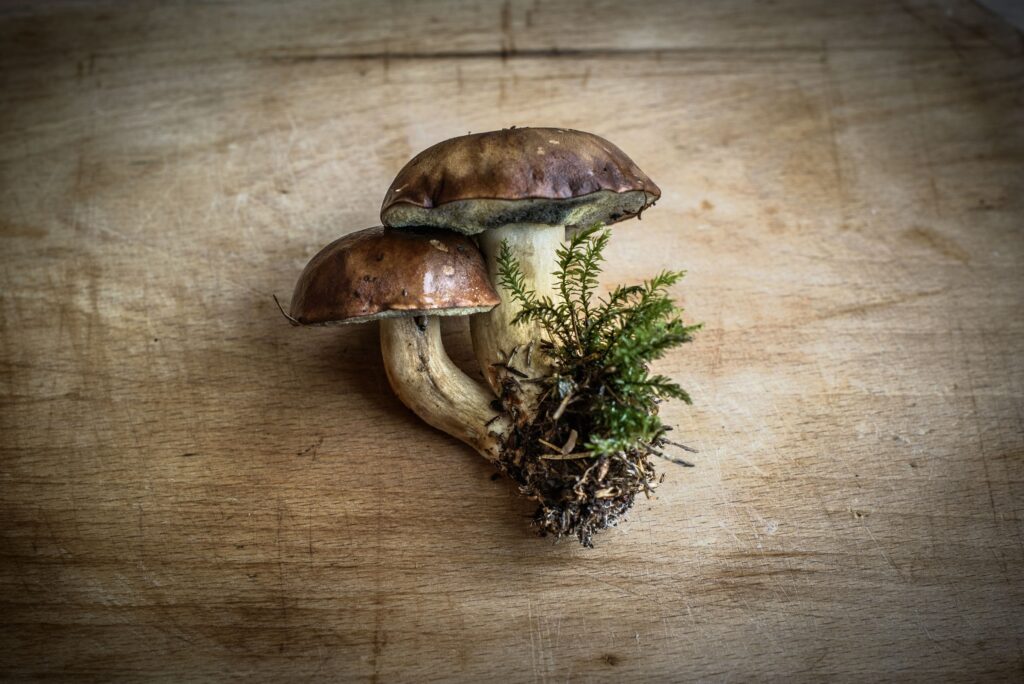
“They grow,” my friend intoned, “in dark places.” She most emphatically did not want mushrooms on her pizza. We teased her for days; after all, she grew in a dark place, too. But fungi are fairly repulsive. Moist, they can be thready or clotlike or clump up as capped, gilled mushrooms with a Styrofoam or woody texture. They live in soil or rot and produce spores. On a bad day, lethal toxins or foaming, odious infections.
And they might save the planet.
We already owe fungi for giving us antibiotics that ended the tyranny of tuberculosis, Hansen’s disease, gangrene, and syphilis, immunosuppressants that made organ transplants possible, compounds that inhibit cancer cells. We also owe them for all our best bread products, because you cannot get light, airy dough without yeast (nor can you have beer, soy sauce, sake, miso, or tempeh). They help us make citric acid, industrial enzymes for detergent, and stonewashed jeans. And could we live (well, yes) without truffle oil and Roquefort cheese?
I stare at the carton of innocuous white button mushrooms in my fridge. Bland, pale, easily dismissed. Shiitake, now, they are interesting. And I love seeing weird mushrooms pop up in the yard; there is such an air of surprise about them. Bet you did not know I was here.
We did not know a lot.
All the folk tales and Beatitudes should have clued us in: Do not underestimate the humble, small, or smelly. Mushrooms are just the visible tip of a vast underground network known as mycelium. It dissolves what is dead, turning it into living soil, and it feeds plants and trees the minerals they cannot extract by themselves. Put that succinctly, its power sounds almost sacramental. Yet the mycelium works beneath our feet, invisible and unacknowledged, like the people who remove bodies during a plague or war. We barely register their existence and would never want to dwell in their world. But what would ours look like without them?
Fungi of various sorts can eliminate or suppress the growth of weeds; termites, bedbugs, grasshoppers, and other insects; mites, and nematodes. White-rot fungi can break down insecticides and herbicides, pentachlorophenol, creosote, coal tars, and heavy fuels, neutralizing their toxicity by separating them into carbon dioxide, water, and basic elements. Other fungi can remove heavy metals, dyes, petroleum fuels, hydrocarbons, benzene, ammonia, X-ray contrast agents, pharmaceuticals and fragrances that resist decomposition, and other contaminants from wastewater or damaged environments. Fungi may even be able to break down uranium oxides, helping remediate radioactive pollution. There are Antarctic fungi that can operate in cold so extreme that other remediation methods are impossible. They can also help us recover precious metals, pulling gold from electronic waste, for example. And now we are finding that oyster mushrooms can break down the cigarette butts littering our streets and beaches and floating in our rivers, lakes, and oceans. A Mexican startup uses the mushrooms to turn cigarette butts into clean cellulose—which means no more worry about the butts leaching nicotine, heavy metals, and other toxins into the environment and then turning into microplastic pollution.
Remediation. The word means restoring balance. Fungi can scrub us clean, turning our toxins and ick into useful enzymes and even the sort of mushrooms we (most of us) love atop our pizza. We already knew to call psilocybin the magic mushroom, because it brings visions of serenity and oneness. If other fungi help us rinse away the toxins and find our balance again, we will have to acknowledge their magic, too.
All those years we spent buying cute ceramic toadstools with red polka-dotted caps for a fairy garden or reading aloud as Alice nibbles a mushroom and grows or shrinks. We were slow to realize the immense capabilities of these tiny, covert organisms. Did we lack imagination? We are so used to superlatives, we automatically equate the biggest with the best. Bright colors and shiny surfaces interest us, not shy, spongy dun fungi. Or maybe it was an instinctive squeamishness that led us away, a fear of poison, a fear of the unknown. Now, like the knights of yore, we are on a dangerous quest, and true to the narrative, we have to overcome our aversions and look beneath the surface, find our charm or talisman in the least likely place of all.
Read more by Jeannette Cooperman here.
